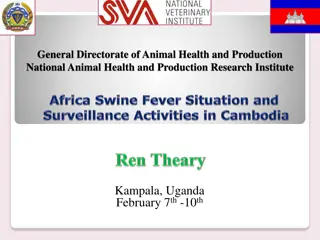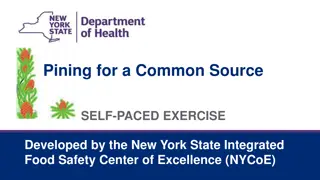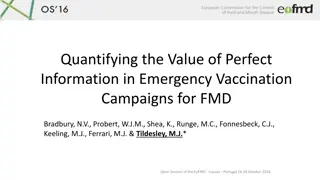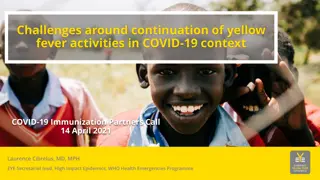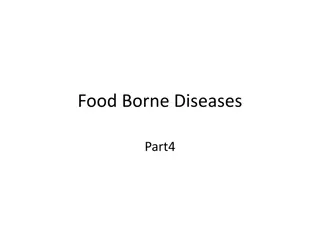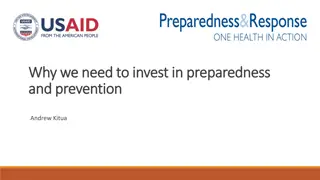Analysis of Listeriosis Rates in Europe 2017-2022
The data presents Listeriosis rates in various European countries from 2017 to 2022, showing cases and rates per country. The information reflects trends in foodborne diseases and highlights differences in morbidity and mortality rates across nations.
0 views • 17 slides
Essential Food Safety Training Program in Abu Dhabi
The Essential Food Safety Training (EFST) program in Abu Dhabi is designed to equip food handlers with the knowledge and skills necessary to ensure safe food handling practices. Led by experienced trainers like Navas Khan A., the program covers essential pillars such as avoiding cross-contamination,
2 views • 26 slides
A Risk Factor Study on Food Establishments in Kansas
Explore a risk factor study conducted on food establishments in Kansas by Crystal Futrell, a Kansas State University MPH candidate specializing in Food Safety and Biosecurity. The study delves into the history of the Kansas Department of Agriculture, its various programs related to food safety and l
0 views • 68 slides
ASF Outbreak Surveillance and Control Strategies in Cambodian Pig Farming
An overview of the African Swine Fever (ASF) outbreak in Cambodia, highlighting the detection of outbreaks in various provinces, outbreak containment efforts, common pig diseases in Cambodia, surveillance objectives, and sampling methods for ASF detection in pigs. The initiative aims to prevent ASF
0 views • 20 slides
Avian Influenza Overview and Outbreak History in South Africa
Avian Influenza, specifically Highly Pathogenic Avian Influenza (HPAI) outbreaks in South Africa, have been documented since 2004, affecting primarily ostriches and poultry. Wild bird transmission remains a concern, with risk factors such as rainfall, temperature, wetlands, and poultry movements con
2 views • 25 slides
Building Resilience Against Cholera Outbreaks: Lessons from IHR Framework
Exploring how the International Health Regulations (IHR) can enhance preparedness and response to cholera outbreaks. Discusses the functional components of IHR, the role of National IHR Focal Points, and best practices in building resilience. Highlights the importance of coordination, communication,
2 views • 20 slides
A Look Into Cholera Control and WASH Services Worldwide
The World Health Organization, along with the Global Task Force for Cholera Control, is focusing on analyzing reported cholera cases from 2010-2021 and the levels of water, sanitation, and hygiene (WASH) services in various countries. The report highlights the importance of basic WASH services in pr
3 views • 9 slides
Comprehensive Overview of Continuity of Business in FAD Outbreaks
Continuity of Business (COB), also known as managed movement, is a crucial strategy that allows the movement of non-infected animals and non-contaminated animal products during a Foreign Animal Disease (FAD) outbreak. This approach helps maintain normal business operations in agriculture and food in
4 views • 27 slides
Epidemiology Investigation and Response in FAD Outbreaks
This presentation covers the phases of epidemiological investigation in Foreign Animal Disease (FAD) outbreaks, including the descriptive, analytic, and intervention phases. It discusses the collection of information, diagnostic testing, disease risk factors, associations, and identifying the FAD ag
1 views • 14 slides
Understanding Microbiology of Food and Foodborne Diseases
This introduction delves into the world of microbiology in relation to food, exploring key terms such as foodborne diseases, food hygiene, contamination, and more. It covers crucial concepts like toxic-infection, carriers, pathogens, and vectors, shedding light on the importance of food safety pract
1 views • 32 slides
Food Safety Guide for Delivery Drivers of Home-Delivered Meals
This guide emphasizes the importance of food safety for delivery drivers handling home-delivered meals, particularly for vulnerable populations. It covers topics such as temperature control, safe food handling practices, and packaging guidelines to ensure the meals remain safe for consumption. Adher
0 views • 37 slides
Comprehensive Guide to Personal Hygiene in Food Handling
Understanding the importance of personal hygiene in food handling operations is crucial for maintaining a safe environment and preventing contamination. This guide explores the key practices and procedures involved in maintaining high standards of hygiene in food preparation, storage, and handling a
0 views • 30 slides
Implementation of nOPV2 for cVDPV2 Outbreak Response
Circulating Vaccine-Derived Poliovirus (cVDPV) outbreaks, particularly cVDPV type 2 (cVDPV2), have increased in recent years. The novel oral polio vaccine type 2 (nOPV2) is an innovative tool developed over nearly 10 years to combat these outbreaks. Clinical trials have shown that nOPV2 provides com
0 views • 18 slides
Epi-Ready: Investigating Foodborne Outbreaks & Epidemiologic Approaches
In Module 6 of the Epi-Ready Epidemiologic Investigation series, participants learn about epidemiologic approaches in responding to foodborne outbreaks. The module covers methods for information gathering, measures of association, statistical significance, case definitions, surveillance activities,
1 views • 41 slides
Understanding Foodborne Illness: Causes and Symptoms
Foodborne illnesses are diseases transmitted to humans through contaminated food, causing symptoms like nausea, vomiting, stomach cramps, fever, and diarrhea. These illnesses are mainly caused by pathogenic microorganisms such as bacteria, viruses, and parasites, often spread through mishandling of
0 views • 10 slides
County Fair Chocolate Scare Case Study - Colorado Integrated Food Safety Center for Excellence
Based in Denver, Colorado, this case study discusses a foodborne illness outbreak at a county fair due to unintentional marijuana-infused food consumption. The study aims to prompt discussions among health professionals on responding to such outbreaks, outlining objectives like identifying unintenti
2 views • 50 slides
Understanding Cyclosporiasis Outbreaks in Georgia: A Comprehensive Overview
Explore the prevalence of Cyclospora outbreaks in Georgia from 2005 to 2015, including historical data, diagnosis methods, demographic insights, and notable past outbreaks linked to foodborne sources. Learn about the parasite Cyclospora cayetanensis, its symptoms, diagnosis challenges, and the cycli
1 views • 21 slides
Foodborne Illness Outbreak Investigation Procedures and Protocols
In this self-paced exercise developed by the New York State Integrated Food Safety Center of Excellence, learners will delve into the intricacies of investigating foodborne illness outbreaks. The course covers topics such as identifying outbreak patterns, roles in outbreak investigations, interpreti
0 views • 171 slides
Insights into the Plague: Epidemiology, Etiology, and Outbreaks
The Plague, caused by Yersinia pestis, has a chilling history spanning pandemics like the Justinian Plague and the Black Death. Understanding its etiology, family, and pathogenicity is crucial. This deadly disease has had notable outbreaks in India, emphasizing the importance of recognizing its host
0 views • 24 slides
Importance of Kitchen Safety and Foodborne Illness Prevention
Understanding the significance of kitchen safety and foodborne illness prevention is crucial to maintaining a safe and sanitary cooking environment. This overview delves into the risks associated with improper practices, such as wearing jewelry while cooking, consuming raw cookie dough, and the pote
0 views • 29 slides
Lessons Learned from Large-Scale Foodborne Illness Investigation
This presentation discusses a Salmonella Bareilly outbreak investigation involving sushi in 2012. It covers the roles of various agencies, surveillance methods, and key events during the investigation. The importance of early detection and collaboration in managing foodborne illnesses is highlighted
0 views • 42 slides
Understanding Food Safety and Preventing Foodborne Illness
Exploring the importance of food safety, this content delves into common bacteria found in human intestines, food recalls, and outbreaks caused by E. coli and Salmonella. It highlights initiatives by CDC in monitoring, detecting, and preventing foodborne diseases, emphasizing the significance of sur
0 views • 16 slides
- Risks of Foodborne Illnesses During Pregnancy
- Pregnant women are at high risk of foodborne illnesses due to weakened immune systems. Such illnesses can lead to serious health issues for both mother and fetus, including miscarriage and premature delivery. Symptoms may include stomach-related discomfort, vomiting, and diarrhea. Immediate medica
0 views • 15 slides
Managing Uncertainty in Emergency Vaccination Campaigns for FMD
Exploring the value of perfect information and the dynamics of information analysis during disease outbreaks, particularly focusing on emergency vaccination for Foot-and-Mouth Disease (FMD). Addressing uncertainties surrounding FMD control, vaccine effectiveness, capacity, and optimal vaccination st
0 views • 25 slides
Challenges in Continuing Yellow Fever Activities Amid COVID-19
Challenges persist in sustaining yellow fever activities during the COVID-19 pandemic, with decreased surveillance, delayed outbreak responses, and logistical disruptions impacting efforts to eliminate yellow fever epidemics. The EYE partnership focuses on protecting at-risk populations, preventing
0 views • 9 slides
Understanding E. coli O157:H7 Outbreaks and Investigations
Explore the characteristics, pathotypes, serotypes, and lifestyle of E. coli O157:H7, a dangerous pathogen responsible for outbreaks linked to various food sources. Discover its growth conditions, toxins, symptoms, and ways it contaminates food, leading to public health concerns and investigations.
0 views • 16 slides
Insights into Salmonella Bacteria and Outbreaks
Salmonella is a Gram-negative, rod-shaped bacterium that is commonly found in food and can cause infections in humans. It belongs to the Enterobacteriaceae family and has various subspecies with different characteristics and serovars. Understanding its nomenclature, growth characteristics, and commo
0 views • 19 slides
Understanding the Microworld: Factors Affecting Foodborne Pathogens
This chapter delves into the microworld of microorganisms and pathogens that can contaminate food, leading to foodborne illnesses. It covers key terms such as bacteria, viruses, parasites, and fungi, along with topics on preventing contamination, understanding spores, and the temperature danger zone
0 views • 25 slides
Understanding Clostridium Perfringens Intoxication: Causes and Characteristics
Clostridium perfringens intoxication is a foodborne illness caused by the ingestion of food contaminated with enterotoxigenic strains of C. perfringens, leading to the production of Clostridium perfringens enterotoxin (CPE). This article discusses the characteristics of CPE, the origins of the organ
2 views • 23 slides
Outbreak Investigation and Management in Public Health
Outbreak investigation is crucial in understanding, distinguishing, and managing disease outbreaks. This involves identifying the nature of outbreaks, studying key terms like endemic and epidemic, and examining outbreak settings such as food-borne and water-borne scenarios. By investigating outbreak
0 views • 53 slides
Public Health Events in WHO Africa Region: Outbreaks Overview
Public health events in the WHO Africa Region pose a significant threat to global health security, with frequent outbreaks of diseases like Ebola, Yellow Fever, Polio, and cholera. In 2015, 105 public health events were reported, the majority being infectious diseases. Ongoing outbreaks in Angola, D
2 views • 30 slides
Understanding Food Safety: Essential Knowledge and Practices
Exploring the fundamentals of keeping food safe, this content covers topics such as foodborne illnesses, contaminants, food safety responsibilities, key terms like time-temperature abuse and cross-contamination, and high-risk populations. Discover how to identify foodborne illnesses and recognize fa
0 views • 22 slides
Understanding Foodborne Diseases and Pathogenic Microorganisms in Foods
Foodborne diseases in humans are caused by consuming contaminated food or water containing pathogenic microorganisms or toxins. These diseases can be categorized into intoxication, infection, and toxicoinfection, each with distinct modes of illness. Pathogens like Staphylococcus aureus, Clostridium
0 views • 5 slides
Importance of Investing in Preparedness and Prevention to Address Outbreaks and Pandemics
Investing in preparedness and prevention is crucial to mitigate the devastating impacts of outbreaks, epidemics, and pandemics. Preparedness helps identify gaps in systems and enhance vigilance, while prevention allows for effective interventions to minimize risks and save resources, ultimately prom
0 views • 11 slides
Ensuring Food Safety: Traceability in Food Systems
In the world of increased foodborne illnesses and global food trade, the focus on traceability of food sources is crucial to containing outbreaks efficiently and cost-effectively. This guide discusses the importance of traceability, the technologies involved, and the balance between costs and benefi
0 views • 21 slides
Importance of Sanitation in Food Handling
Behind culinary success lies years of training and a solid grasp of food safety basics. Unsafe food handling can lead to foodborne illnesses, outbreaks, and even legal consequences. Sanitation practices are crucial to prevent contamination and ensure food safety in professional kitchens, reducing th
0 views • 8 slides
Managing MDR Gram-negative Enterobacteriaceae Outbreaks in Hospitals: Response Strategies and Best Practices
Hospitals face a growing threat from multidrug-resistant Gram-negative bacteria, such as Acinetobacter baumannii and Klebsiella pneumoniae. This article discusses the emergence of carbapenem-resistant Enterobacteriaceae in Europe and outlines response strategies, including lab screening, communicati
0 views • 23 slides
Investigating Foodborne Illness Outbreaks Linked to Events
An organization is investigating outbreaks of foodborne illnesses associated with two different events: a wedding in Pueblo and the National Western Stock Show. The wedding outbreak involves confirmed cases of Norovirus, affecting several guests, while the stock show outbreak is linked to E. coli O1
0 views • 16 slides
Understanding Influenza: From Pandemics to Avian Flu Outbreaks
Influenza is a viral respiratory illness that can range from seasonal flu to pandemic outbreaks like the 2009 swine flu (H1N1) epidemic. The dangers and prevention methods of specific strains, such as H5N1 avian flu, have been witnessed since 2003. This summary delves into the characteristics, impac
0 views • 13 slides
Understanding Food Safety: Microorganisms, Illnesses, and Prevention
Explore the world of food safety through the lens of microorganisms, illnesses, and prevention methods. Learn about different types of bacteria that can cause foodborne illnesses, such as Clostridium Perfringens and Staphylococcus Aureus, and understand the distinction between food intoxication and
0 views • 12 slides



